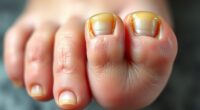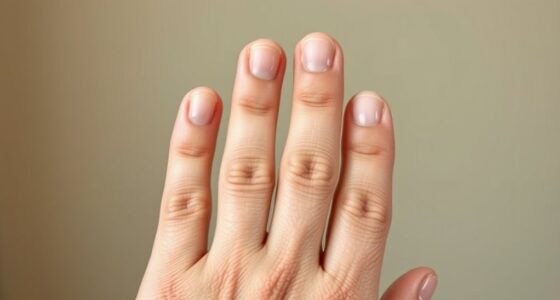Nail ridges are lines that appear on the nail surface, often caused by aging, nutritional deficiencies, trauma, or health conditions like psoriasis. Vertical ridges are usually harmless but can indicate a need for better nutrition or hydration, while horizontal ridges may signal more serious issues like illness or injury to the nail matrix. Proper care, good nutrition, and gentle nail maintenance help improve their appearance. You’ll find tips to keep your nails healthy if you continue exploring.
Key Takeaways
- Vertical ridges are common, harmless, and often linked to aging or nutritional deficiencies like zinc or iron.
- Horizontal ridges (Beau’s lines) indicate temporary growth disruptions from trauma, systemic illness, or severe infections.
- Nutritional deficiencies, medical conditions, aging, and external trauma are primary causes of nail ridges.
- Proper nail care, moisturization, biotin supplements, and avoiding harsh chemicals can help reduce ridges.
- Persistent ridges or changes in nail appearance should be evaluated by a healthcare professional.
Types of Nail Ridges and What They Signify

Nail ridges can vary in appearance, and understanding their types can reveal important clues about your health. Horizontal ridges, known as Beau’s lines, often indicate temporary disruptions in nail growth due to illness or stress. Vertical ridges, which run from nail base to tip, are usually harmless and common with aging, but they can sometimes signal nutritional deficiencies. When you notice ridges, you might consider how nail polish effects or cosmetic treatments could accentuate them, making them more noticeable. While some ridges are purely cosmetic, others may point to underlying health conditions. Recognizing the difference helps you decide whether to seek medical advice or simply enhance your nails with gentle cosmetic treatments to improve their appearance. Additionally, understanding nail health indicators can help you identify early signs of systemic issues that may require medical attention.
Common Causes of Vertical Ridges in Nails
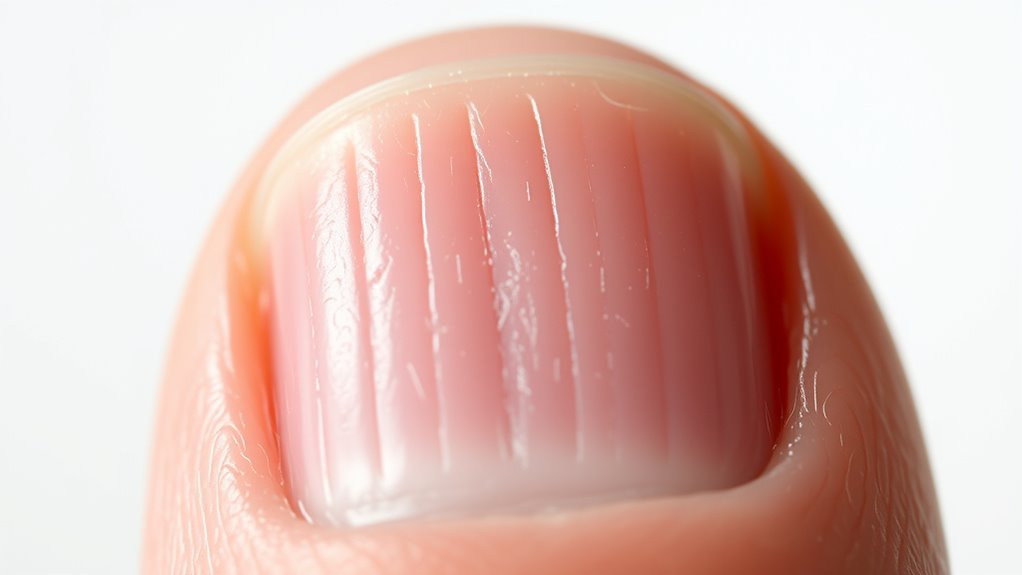
You might notice vertical ridges in your nails and wonder what causes them. Nutritional deficiencies and aging are common factors that can contribute to these ridges. Understanding how these elements affect nail growth helps you identify potential underlying issues. Additionally, sound design techniques such as precise audio editing can be applied metaphorically to understanding the subtle changes in nail texture.
Nutritional Deficiencies
Nutritional deficiencies are a common culprit behind vertical ridges in nails, often signaling that your body isn’t getting enough essential vitamins and minerals. Vitamin deficiencies, particularly of biotin, vitamin A, or B-complex vitamins, can weaken nail structure and cause ridges to form. Mineral imbalances, such as low levels of zinc, iron, or calcium, also play a role in nail health. When your body lacks these nutrients, it struggles to produce strong, smooth nails, leading to ridges that run vertically. Addressing these deficiencies through a balanced diet or supplements can often improve nail appearance. Ensuring adequate intake of key vitamins and minerals helps support collagen production, cell regeneration, and overall nail strength, reducing the prominence of ridges caused by nutritional gaps. Additionally, proper hydration and a diet rich in nutrients essential for nail health can further promote stronger, healthier nails.
Aging and Nail Growth
As we age, changes in nail growth become more noticeable, often leading to the formation of vertical ridges. These ridges are a common part of aging and typically aren’t a sign of serious health issues. You might notice these ridges more when applying nail polish, as they become more prominent with time. Proper cuticle care can help keep your nails healthy and smooth, reducing the appearance of ridges. As your nail growth slows, cells don’t shed as evenly, causing ridges to form vertically. To minimize their appearance, avoid aggressive nail treatments and focus on maintaining healthy cuticles. While aging naturally causes these ridges, good nail and cuticle care can help improve their appearance and keep your nails strong and healthy. Additionally, nail health maintenance through proper hydration and nutrition can support overall nail strength and reduce ridging.
Horizontal Ridges and Their Underlying Factors
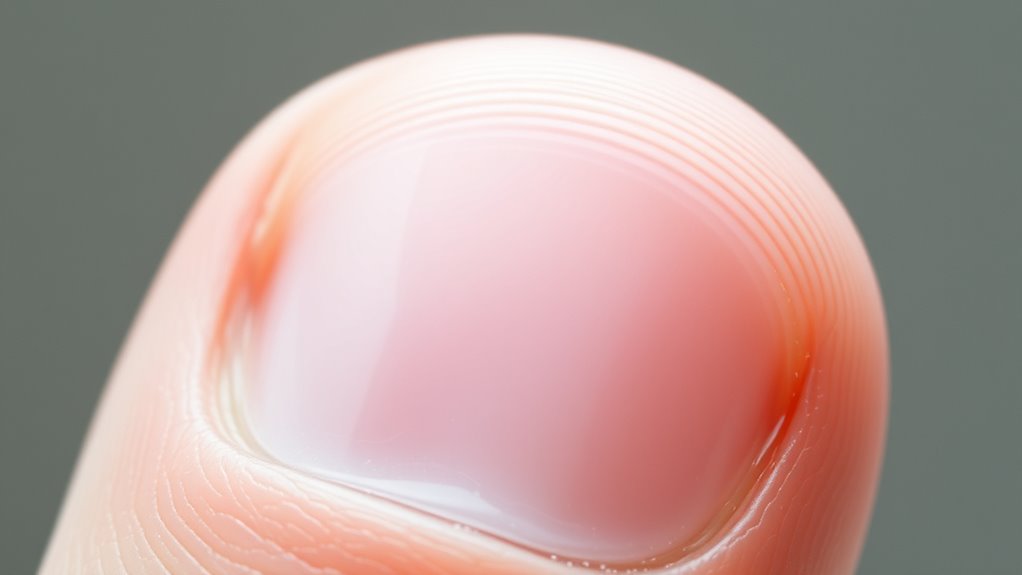
Horizontal ridges on your nails, often called Beau’s lines, can indicate underlying health issues or temporary disruptions in nail growth. These ridges appear as shallow or deep grooves running across the nail plate from side to side. Underlying factors for horizontal ridges include illnesses like severe infections, trauma, or systemic conditions such as diabetes or peripheral vascular disease. Nutritional deficiencies, especially of zinc or protein, can also contribute to these ridges. Additionally, temporary stress or injury to the nail matrix may cause a halt in nail growth, resulting in these lines. Recognizing these ridges can prompt you to consult a healthcare professional for further evaluation, especially if they persist or are accompanied by other symptoms. Addressing the underlying cause is key to treating horizontal ridges effectively. Understanding energetic alignment may also support overall health and recovery.
How Aging Affects Nail Texture and Ridges

As you age, your nails tend to become thinner and more fragile, which can make ridges more noticeable. This change often relates to a decrease in collagen, impacting nail strength and texture. Understanding these shifts helps you better care for your nails as you get older. Additionally, nutritional factors such as deficiencies in vitamins and minerals can contribute to changes in nail appearance and texture nutritional deficiencies.
Thinning Nails Over Time
Over time, aging causes nails to become thinner and more fragile, leading to noticeable changes in texture and the development of ridges. As your nails weaken, they’re more prone to splitting and peeling. To combat this, focus on nail strengthening routines, such as using nourishing nail oils and hardeners that help reinforce the nail structure. Proper cuticle care is equally important; keeping your cuticles moisturized prevents dryness and damage that can contribute to thinning nails. Avoid harsh chemicals and excessive water exposure, which can accelerate fragility. Regularly trimming and filing your nails gently minimizes stress on weak nails. Additionally, using electric nail files can help shape nails smoothly without causing additional stress or damage. By adopting these practices, you support healthier, thicker nails, reducing the prominence of ridges and improving overall nail texture over time.
Collagen and Nail Health
Aging not only weakens nails but also impacts their structural components, with collagen playing a vital role in maintaining nail strength and flexibility. As you age, collagen synthesis slows, reducing the support for the nail matrix—the area responsible for nail growth. This decline causes changes in nail texture, making them more prone to ridges and brittleness. To combat this, focus on a diet rich in nutrients that promote collagen production, such as vitamin C and biotin. Understanding the relationship between collagen and nail health helps you take targeted steps to preserve nail integrity and reduce ridges over time. Additionally, automation technologies are emerging in the field of health and wellness, offering innovative solutions for monitoring and improving nail and skin health.
Nutritional Deficiencies Linked to Nail Changes

Nutritional deficiencies can directly impact the appearance and health of your nails, often causing noticeable changes. When your diet lacks essential nutrients, your nails may develop ridges, become brittle, or show other abnormalities. Mineral deficiencies, such as low levels of zinc, iron, or calcium, are common culprits linked to nail changes. Incorporating dietary supplements can help address these deficiencies, promoting stronger, healthier nails. Ensuring your diet includes sufficient vitamins and minerals supports nail growth and repair. If you notice persistent ridges or brittleness, it might be a sign you need to evaluate your nutritional intake. Talk to a healthcare professional about your diet and consider supplements if necessary, but remember that balanced nutrition is key to maintaining healthy, resilient nails. Additionally, optimal angles can influence nail health by affecting overall hand and finger positioning during daily activities.
Medical Conditions Associated With Nail Ridges
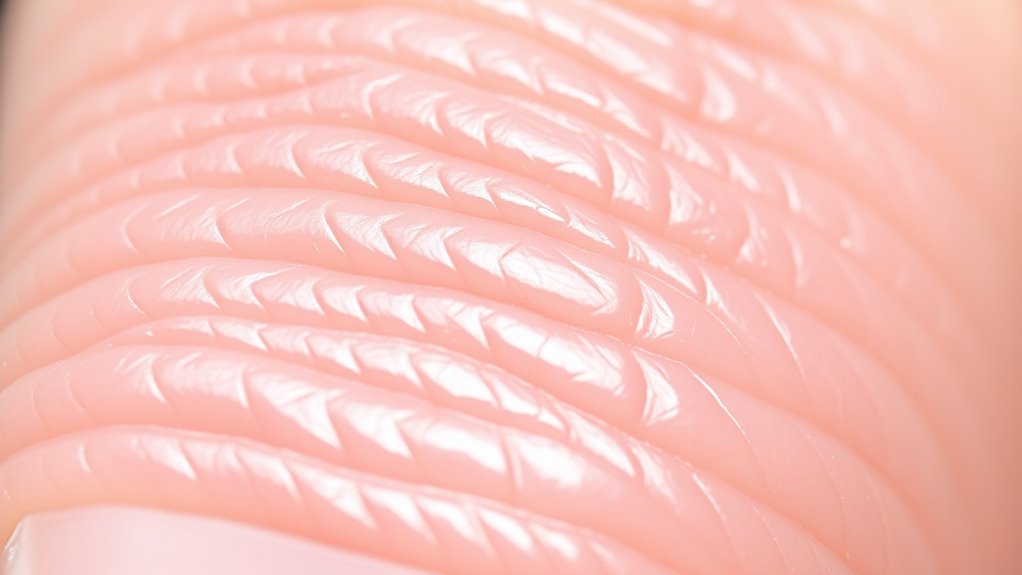
Persistent nail ridges can sometimes signal underlying health issues beyond nutritional deficiencies. Genetic predispositions may cause vertical ridges to develop naturally, especially if they run in your family. These ridges often aren’t a sign of serious health problems, but they can sometimes indicate systemic conditions like psoriasis or eczema. Occupational exposures also play a role; frequent contact with harsh chemicals, detergents, or repeated nail trauma from manual work can lead to ridging. Additionally, certain chronic illnesses, such as rheumatoid arthritis or circulatory disorders, may contribute to nail changes. Recognizing these patterns helps you determine whether your ridges are benign or linked to a medical condition. Modern farmhouse decor styles often incorporate natural materials and vintage furnishings, creating a cozy and authentic atmosphere. If you suspect an underlying health issue, consult a healthcare professional for proper diagnosis and treatment.
The Role of Nail Trauma in Ridge Formation
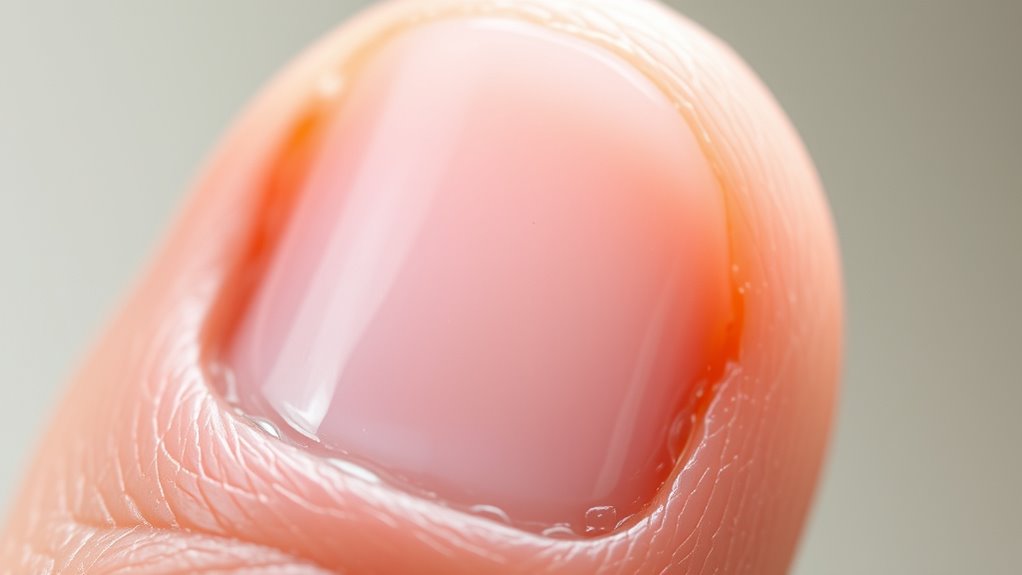
Nail trauma is a common cause of ridge formation, as repeated injury or stress to the nails can disrupt normal keratin growth. When you experience trauma, such as hitting or banging your nails, it can damage the nail matrix—the area responsible for nail production. This damage interrupts the smooth process of keratin deposition, leading to the development of ridges that run vertically or horizontally. Over time, ongoing trauma can cause persistent ridge formation, making the ridges more noticeable. It’s important to recognize that even minor injuries, like aggressive manicures or nail biting, can contribute to this process. Protecting your nails from trauma helps maintain healthy nail growth and prevents the formation of ridges caused by repeated injury.
Home Remedies and Over-the-Counter Treatments

Fortunately, there are several home remedies and over-the-counter treatments that can help improve the appearance of nail ridges. Applying a clear nail polish can smooth out ridges and give your nails a glossy finish, making imperfections less noticeable. Regular hand massages using moisturizing oils or creams can also promote healthier nails by improving circulation and hydration, which may reduce the prominence of ridges over time. Additionally, using gentle exfoliation methods can remove dead skin around the nails, enhancing their overall look. Over-the-counter nail strengthening treatments and biotin supplements can support nail health from within. Consistent care, combined with these simple remedies, can help improve the texture and appearance of your nails, making ridges less prominent and your nails stronger.
When to Seek Professional Medical Advice

While home remedies and over-the-counter treatments can improve the appearance of nail ridges, it’s important to recognize when professional medical advice is needed. If you notice changes like persistent lines, discoloration, brittleness, or pain, consult a healthcare provider. These signs may indicate underlying health issues requiring diagnosis and treatment beyond cosmetic treatments, such as medical conditions affecting your nails. Additionally, if nail polish effects don’t improve ridges or cause irritation, seeking advice is prudent. Early intervention can prevent complications and ensure proper care. Consider consulting a dermatologist if your nail ridges worsen or are accompanied by other symptoms.
| Symptom | Possible Cause | Action |
|---|---|---|
| Persistent ridges or lines | Underlying health conditions | Seek medical advice |
| Discoloration | Fungal infection or health issue | Visit a healthcare provider |
| Brittle or cracked nails | Nutritional deficiencies or damage | Consult a specialist |
| Pain or swelling | Infection or trauma | Get professional evaluation |
| No improvement after cosmetic treatments | Ineffective treatments or underlying problem | See a doctor for diagnosis |
Tips for Maintaining Healthy, Ridgeless Nails
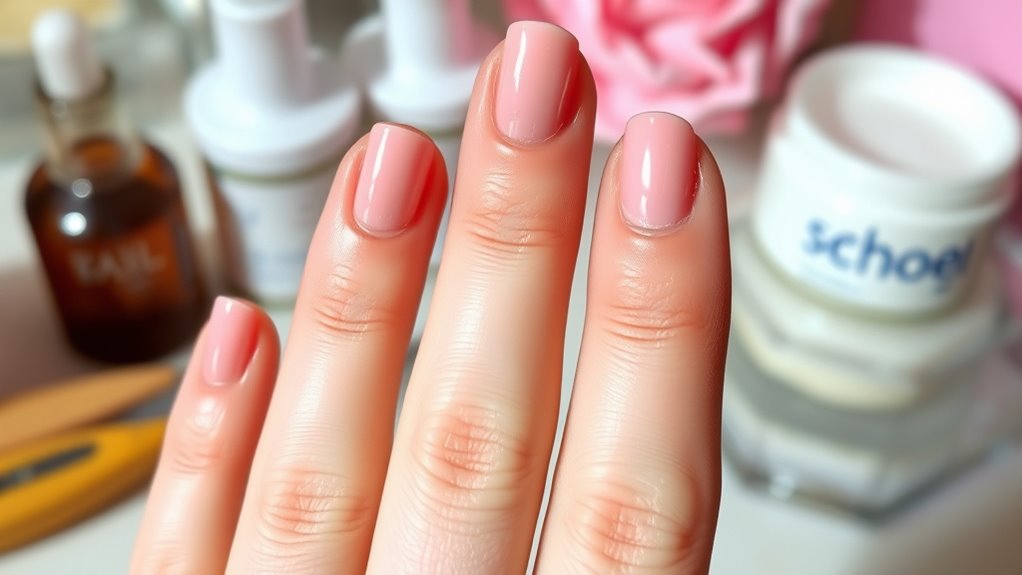
To keep your nails healthy and ridgeless, make sure you hydrate your body daily by drinking plenty of water. Apply nourishing oils to your nails and cuticles to strengthen them, and try to limit exposure to harsh chemicals like acetone or strong detergents. These simple steps can make a noticeable difference in improving your nail appearance and overall health.
Hydrate Properly Daily
Staying well-hydrated is essential for maintaining healthy, ridgeless nails. Proper hydration keeps your nails flexible, prevents dryness, and supports overall nail health. Drinking enough water daily helps keep your cuticles soft and reduces the risk of ridges forming. When your nails are well-hydrated, applying nail polish becomes smoother and lasts longer. Remember to incorporate cuticle care into your routine, as hydrated cuticles prevent tearing and hangnails.
Here’s a quick guide:
| Hydration Tips | Benefits |
|---|---|
| Drink 8+ glasses of water daily | Keeps nails and cuticles moist |
| Use hand creams with emollients | Protects against dryness |
| Limit caffeine and alcohol | Prevents dehydration |
| Maintain a balanced diet | Supports nail strength |
Use Nourishing Oils
Using nourishing oils is an effective way to maintain healthy, ridgeless nails. Regularly applying oils like jojoba, castor, or vitamin E helps strengthen nails and keeps them moisturized. This prevents dryness caused by nail polish removal or acrylic nails, which can damage the nail surface. To maximize benefits:
- Massage a few drops of oil into your nails and cuticles daily.
- Use oils before bed for overnight hydration.
- Apply oil after removing nail polish to restore moisture.
- Combine oils with a gentle nail and cuticle massage to boost circulation.
These simple steps support healthy nail growth and reduce ridges. Incorporate nourishing oils into your routine to keep your nails resilient and smooth, especially if you frequently use nail polish remover or wear acrylic nails.
Limit Harsh Chemicals
Exposing your nails to harsh chemicals found in certain nail polishes, removers, and cleaning products can weaken the nail surface and cause ridges. Chemical exposure damages the keratin structure, making nails more prone to ridging and splitting. Nail polish effects, especially those with formaldehyde, toluene, or acetone, can strip away natural oils and compromise nail health over time. To maintain healthy, ridgeless nails, opt for acetone-free removers and use nail polishes labeled as gentle or free from harmful chemicals. Always give your nails a break from polish to allow them to breathe and recover. Protect your nails by wearing gloves during cleaning, and choose nourishing base coats that reinforce nail strength and prevent chemical damage.
Frequently Asked Questions
Can Nail Ridges Indicate Early Signs of Serious Health Issues?
Nail ridges can sometimes be disease indicators or signs of nutritional deficiencies, but they’re often harmless. If you notice new or changing ridges, it’s wise to consult a healthcare professional to rule out serious issues like psoriasis or anemia. Keep an eye on other symptoms, and guarantee your diet includes essential nutrients. Addressing underlying health concerns can help improve nail health and prevent potential complications.
Are There Specific Medications That Cause Nail Ridges?
Certain medications can cause nail ridges as a side effect, leading to drug-induced changes in your nails. These medications may include chemotherapy drugs, antibiotics, or retinoids, which interfere with nail growth and health. You might notice ridges developing or worsening after starting new treatments. If you suspect medication side effects are affecting your nails, consult your healthcare provider to explore alternatives or solutions to manage these drug-induced changes effectively.
How Long Does It Take for Ridges to Grow Out Completely?
It typically takes about 6 months for nail ridges to grow out completely, as fingernails grow roughly 3 millimeters per month. Your growth timeline varies depending on age, health, and nail care. To speed up ridges removal, keep nails moisturized, avoid trauma, and consider supplements if recommended by a healthcare professional. Patience is key, since ridges gradually grow out as your nails regenerate.
Can Nail Ridges Be Prevented With Daily Nail Care Routines?
Yes, you can prevent nail ridges with proper nail care and prevention strategies. Keep your nails moisturized, avoid harsh chemicals, and maintain a healthy diet to support nail strength. Regularly filing nails gently and avoiding aggressive manicures also help reduce ridges. By incorporating these routines into your daily nail care, you minimize the chances of developing prominent ridges and promote healthier, smoother nails over time.
Are There Age-Specific Differences in Nail Ridge Appearance?
Yes, age-related changes can influence nail ridge appearance. As you age, developmental stages cause ridges to become more prominent, especially vertical ridges, due to slower cell turnover and decreased collagen. Younger individuals tend to have smoother nails, while older adults often notice more pronounced ridges. These changes are normal, but if you see sudden or severe differences, it’s best to consult a healthcare professional to rule out underlying issues.
Conclusion
Think of your nails as a map, each ridge telling a story of your body’s journey. Some lines are just gentle trails, while others mark important landmarks of health. By understanding what these ridges mean, you can navigate your way to healthier nails. Pay attention to their signs, nurture your body, and seek help when needed. With care, your nails can become a clear, smooth roadmap of well-being, guiding you toward better health every step of the way.

